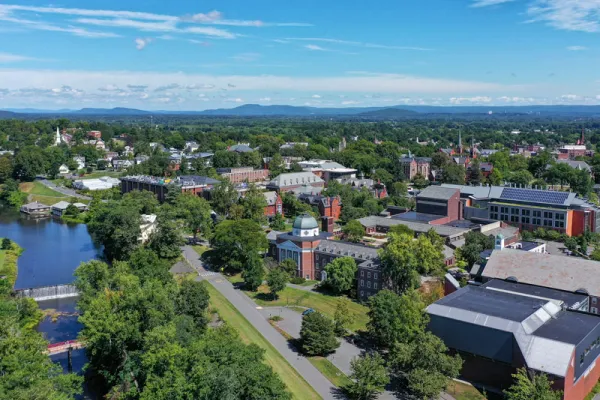‘Modeling What Carbon Neutrality Really Means’
Sustainability

Published May 2, 2022
Smith is acting in the face of the climate crisis.
Just one week after commencement, the college will break ground on a bold new infrastructure project—one that will allow Smith to realize its pledge of becoming carbon neutral by 2030.
What’s more, Smith will achieve its carbon-neutral goal sooner than many schools and with minimal use of offsets, investing instead in a state-of-the-art geothermal project that over the next six years will transform the college’s approach to heating and cooling and reduce Smith’s carbon emissions by an astounding 90 percent.
It’s a dramatic and leaderly move, one that makes Smith one of a handful of colleges nationally to achieve net-zero carbon emissions through the near elimination of on-campus fossil fuel combustion rather than through other means, such as carbon offsets or biofuel conversion.
In announcing the decision, President Kathleen McCartney noted that it is “a moral imperative for Smith College to do its part in mitigating the devastating effects of climate change on our planet. As such,” she said, “I am enormously proud of the decision by the Smith Board of Trustees to approve the Geothermal Campus Energy Project.”
The switch to geothermal energy will dramatically lower Smith’s carbon emissions. “This system will single-handedly reduce Smith’s carbon footprint by an astounding 90%,” said Dano Weisbord, Smith’s associate vice president for campus planning and sustainably. “I’m so proud that our team developed a single solution that lowers carbon, lowers cost and improves the campus experience. Electrification will be a real win for Smith.”
Smith will use geothermal energy to replace the combustion of fossil fuels for heating with a geothermal heat-exchange system that uses renewable electricity. This technology harnesses the stable temperature in the earth below the frost line and transfers it from the ground to an energy plant, and then on to individual buildings for heating and cooling.
More than a decade in the making, Smith’s geothermal energy project represents years of effort by dozens of students, faculty, staff and alums, including those on the Study Group on Climate Change and the District Energy Working Group.
Lucy Metz ’22 has been an eager and integral part of the process since her first day on campus, serving on the DEWG and conducting research with environmental science professor Alex Barron, among other things. “Climate change is such a far-reaching problem,” Metz says. “It can be hard to have a vision to aim for. It’s very powerful for students to live on a campus that’s modeling what carbon neutrality means.”
This isn’t the college’s first foray into geothermal heating and cooling. Smith began using geothermal energy in 2019, when the college undertook a pilot project that involved heating and cooling the college’s Field House. Denise McKahn, an associate professor of engineering at Smith, and several students have conducted research into the project and are glad to have helped push carbon neutrality forward. “People will walk our campus knowing that we commit to the hard work of aligning our practice to our values,” McKahn said. “We’re glad to have played a part in this important work.”
McKahn’s 2019 work is just one example of faculty-student involvement in the project. Students have conducted research on the future use of batteries at Smith and on the carbon-neutrality approaches of other colleges and universities, presenting their research at conferences and to Smith’s trustees in advance of the board’s review of the project. It is, Weisbord says, a prime example of “the campus as classroom.”
Want to learn more about Smith’s geothermal energy project? Join one of the many events that CEEDS has organized this spring or next fall, or watch this video by Abby Golden ’23. Learn more by reviewing Smith’s FAQ and CEEDS information online. Smith has set up a website to provide regular updates on construction and other issues.
Weisbord notes that the end goal of the geothermal project isn’t just a new heating and cooling system for the college—it’s a significant reduction in carbon emissions for Smith, and for the City of Northampton. “This project has been informed by the experiences of others,” he notes, “and we hope that it will serve as a model for others. We are excited to show our students that through projects like this, we have the ability to avoid the worst impacts of climate change.”
Photograph by Jeff Baker